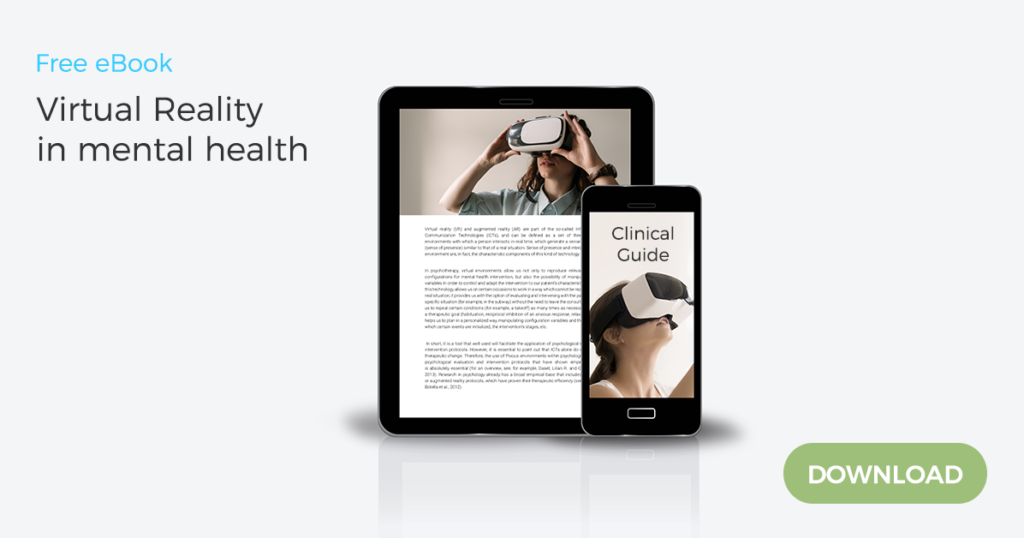Immersive environments are increasingly used to treat disorders that involve managing complex emotions. Reproducing situations that generate anxiety in the patient and being able to treat them with the therapist at the time of the experience can reinforce the benefits of traditional therapy. Several studies have shown how Virtual Reality (VR) brings great benefits in the treatment of Eating Disorders (eating disorders).
One of the most recent theses extracted from Exposure Therapy through Virtual Reality in eating disorders (1) analyzes 13 studies of samples of patients with eating disorders and population without eating disorders to which they are exposed to virtual reality environments and stimuli. The results show evidence about the ability of VR to cause anxiety responses in patients with eating disorders and, therefore, its effectiveness in exposure therapy. The study also detects the efficient use of VR for the prevention of binge eating behavior in patients with bulimia and binge eating disorder.
In parallel, the University of Nottingham and the University of Nottingham Trent are working in collaboration with the technology company Radford Body Aspect and the national innovation agency InnovateUK to develop tools that could help patients with eating disorders to manage their reactions to the exposure food.
In Amelia Virtual Care we believe that by incorporating virtual reality to this type of therapy, the experience is much more immersive and helps to have a more direct link with the complex emotions experienced by patients with eating disorders. Specifically, Amelia Virtual Care virtual environments evaluate and intervene in disorders such as bulimia nervosa, anorexia nervosa or binge eating disorder, exposing the patient to various scenarios, with the aim of reducing uncontrolled impulse towards food.
VR sessions to normalize eating patterns
Our sessions in virtual environments normalize eating patterns that help patients be aware of the distortion of their body image, confront and correct it, as well as achieve a more realistic perception of dissatisfaction with their own body (2).
One of the environments we work on is the costumes, a scenario designed to work on the distortion of body image. The tool allows the patient to modulate their body dimensions through a customizable avatar. The user creates the avatar of how he perceives himself and, on the other hand, the therapist generates a silhouette with his real body dimensions. In this way, the patient checks for himself the distortion between the perception of his own body and reality.
Another environment developed on the Amelia Virtual Care platform is a restaurant. The patient can eat alone or accompanied and the therapist selects a hypocaloric, diuretic, standard or hypercaloric menu, depending on what the situation requires.
In this environment, anxiety is worked towards certain foods as well as the awareness of how good eating habits can prevent a subsequent purge, since when the patient feels that he has transgressed the diet and wishes to vomit, the therapy works for him to try to analyze what you feel and think and discuss it in situ.
In subsequent sessions with our platform, systematic exposure to the restaurant environment continues, where the therapist asks about the thoughts, emotions, and difficulties the patient is experiencing. In addition, new tasks are being added (eating together with other people, eating a diet of standardized amounts, etc). Each session incorporates new challenges and analyzes the previous advances together with the patient.
It should be added that from Amelia Virtual Care we offer a complete virtual reality training network as well as support and monitoring of clinical work. In addition, our platform offers courses, seminars, manuals and videos of continuous training, which help to improve the effectiveness of each of the treatments with which the therapists who perform the VR sessions work.
References
1 Vilalta, F., Pla, J., Ferrer, M., & Gutiérrez, (2015). Terapia de exposición mediante Realidad Virtual en los trastornos alimentarios: presente y futuro. Revista Tesis Psicológica, 10 (2), 12-37
2 (Gutiérrez-Maldonado et al., 2016; Lafond, Riva, Gutierrez-Maldonado, & Wiederhold, 2016; Lozano et al, 2002; Marco, Perpiñá & Botella, 2013; Manzoni et al, 2013; Manzoni et al, 2016; Perpiñá, Botella & Baños, 2003; Perpiñá et al., 2013; Pla-Sanjuanelo et al., 2015; Riva, 2011: Riva et al, 1999; Wiederhold, Riva, & Gutiérrez-Maldonado, 2016).












